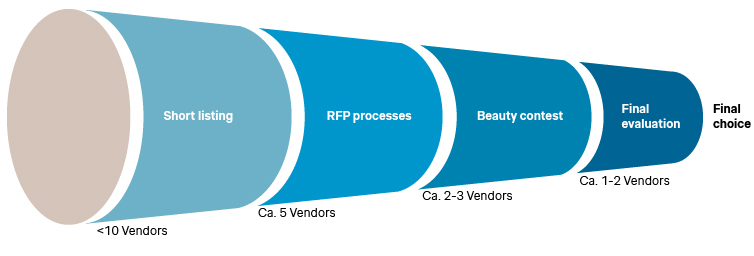Understanding which vendor delivers the ideal software and fulfils a wide range of requirements is usually a multi-week process. Our step-by-step guide from Simon-Kucher Elevate helps you avoid the most common pitfalls, saving you valuable time and money.
With hundreds of vendors in the technology market offering seemingly similar products, the vendor selection process can feel like navigating a gigantic jungle. An ever-expanding supply of software has made finding the right software a complicated task indeed.
To further complicate matters, software categories are often not standardized and have overlapping features. It's not uncommon for buyers to struggle to differentiate between various vendors, as many present themselves as reliable and competent, showcasing a multitude of features.
The vendor selection process can help you learn more about and distinguish between vendors. But only if you, as a buyer, follow the right approach. We share six common errors in the vendor selection process and how to avoid them.
Our guide for the vendor selection process
We recommend following the steps one after the other to get the most out of this vendor selection process guide.
1. Avoid undefined end-to-end processes
One of the most common vendor selection pitfalls is a poorly defined end-to-end process. To circumnavigate this, you must clearly understand how the software will fit into your existing (or future) commercial process and what impact it should create.
The first step is to map out the end-to-end commercial process. Having a clear understanding of the current "AS-IS" process enables you to define the "TO-BE" process. This helps you create an exhaustive list of requirements, providing a structure for the vendor selection process.
By defining the end-to-end process before getting started with vendor selection, you ensure that you clearly understand your needs and select the most suitable vendor. This approach also ensures that your selected software solution integrates seamlessly into your existing commercial process, maximizing its potential impact.
2. Unspecific requirements waste everyone's time
With software, the details matter. You don't just need an exhaustive list of requirements, but also specific, well-defined individual requirements that detail the features at a granular level for each element of the commercial process. Unfortunately, many buyers lack such an exhaustive list of requirements, leading to vague or incomplete specifications that require multiple Q&A rounds with potential vendors, prolonging the selection process.
To avoid this pitfall, the team that will use the software and be responsible for its implementation should already be involved in the requirements phase. These subject experts can provide valuable insights into the real-life usage of the software. By taking a collaborative approach to defining the requirements, you ensure the requirements are specific enough and enable a smooth transition to the new software. This approach also streamlines the vendor selection process, reducing the time and resources required to identify the best software solution for your needs.
Here are some general guidelines to document your requirements:
General guidelines on requirements documentation
| Format and scope | ||
|---|---|---|
 | Atomic requirements: Requirements should generally refer to a very specific "atomic" functionality and not combine multiple functionalities; a use case should span multiple requirements | |
 | Process link: Ideally the requirements documentation should provide a 1:1 link back to the process flowchart, as this increases the understanding of the entire process flow by the vendors | |
 | Format: Requirements should be documented in Excel format. An additional word document to describe the process can be an advantage | |
| Content | ||
|---|---|---|
Requirements documents should typically cover five main areas:
| ||
3. Prioritizing requirements: Always know your must-haves
Once you have an exhaustive and specific list of requirements, the next step is to prioritize them. Two categories – must-haves and nice-to-haves – will help you compare vendors and guide the elimination process.
The must-haves are non-negotiable requirements that are necessary for executing the commercial process from your perspective as a buyer. These requirements are tailored to your processes and infrastructure and may include features such as customization, size, stability, and approval workflows. By identifying non-negotiable requirements upfront, you quickly eliminate vendors that don't meet your criteria, streamlining the selection process.
The nice-to-haves are features you would like to include in the software but have some wiggle room. These requirements are driven from a market perspective, based on industry best practices, benchmarks, and your future positioning. For example, a real-time analytics dashboard, chatbots, and other advanced features that are not essential to your processes but could provide significant benefits.
4. Narrowing down a suitable long list
A common mistake during the vendor selection process is creating a provider long list without performing thorough market research. The long list should typically comprise 8-10 vendors who initially appear to meet your requirements. However, starting with an unsuitable long list will lead to difficulties along the process.
To avoid this, it's essential to perform comprehensive market research that checks for industry-specific vendors, market leaders, customization, size and scalability, infrastructure requirements, ballpark costs, and other relevant criteria. This research facilitates the short-listing process, makes sure that you have considered all relevant vendors, and ensures that the demos and presentations apply to your specific requirements.

5. Avoid unspecific software demos
Buyers often make the mistake of not providing specific use-cases they want to see in the software demo. This results in vendors leading the demo and showcasing their best features, which may not align with the buyer's needs. This can make it difficult to compare the demos and tie the features to the must-haves and nice-to-haves.
We recommend having predefined use-cases that include most of your must-haves and a few nice-to-haves. Sharing these use cases with the vendor before the demo allows them to tailor the software demo to your requirements, enabling a less challenging and more thorough evaluation of the vendor.
6. How to deal with demos that do not seem comparable
Buyers often struggle to compare the demos of shortlisted vendors, even after completing the entire vendor selection process. This uncertainty may stem from one or all the pitfalls mentioned above, making it critical to execute the previous steps systematically. While most software vendors offer similar features, the key is to compare them through the lens of your own requirements.
To achieve a smooth evaluation process, a structured and comparable approach is essential. Using the same use-case for vendor demos, applying consistent metrics to rate the vendors, and ensuring uniform communication with all vendors are some effective ways to achieve a comparable evaluation.
Clear guidelines for successful vendor selection
Although some of these points may seem like minor oversights, their consequences can be significant. It's essential to define the process comprehensively, gather specific requirements and prioritize them, select the appropriate long list of vendors, and customize demos to ensure comparability with an evaluation framework. By following these guidelines, you can avoid the most common pitfalls and achieve a smoother vendor selection process.
Want to know more? Contact our experts at Simon-Kucher Elevate to help navigate your vendor selection process.
Additional contributor: Angela Philippi








